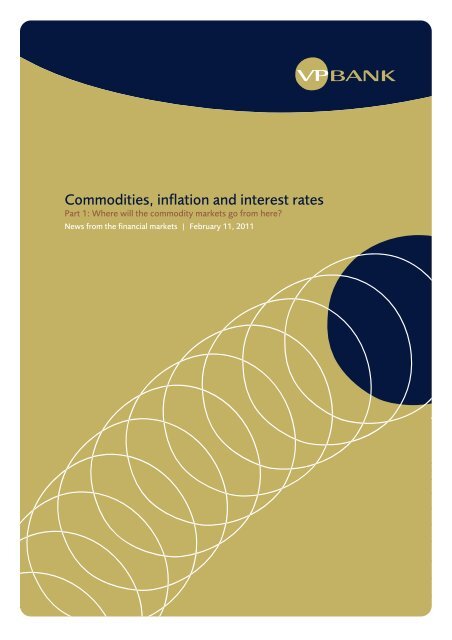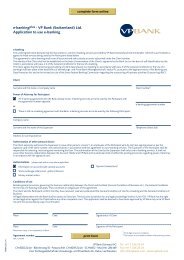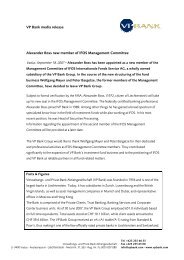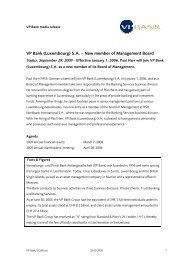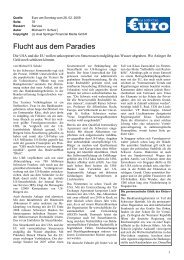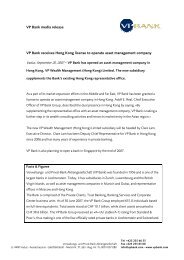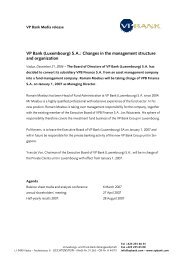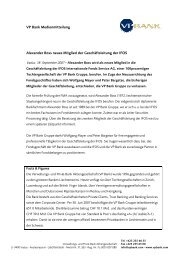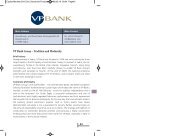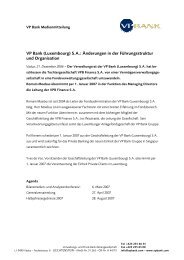Commodities, inflation and interest rates
Commodities, inflation and interest rates
Commodities, inflation and interest rates
Create successful ePaper yourself
Turn your PDF publications into a flip-book with our unique Google optimized e-Paper software.
<strong>Commodities</strong>, <strong>inflation</strong> <strong>and</strong> <strong>interest</strong> <strong>rates</strong><br />
Part 1: Where will the commodity markets go from here?<br />
News from the financial markets | February 11, 2011
<strong>Commodities</strong>, <strong>inflation</strong> <strong>and</strong> <strong>interest</strong> <strong>rates</strong><br />
Part 1: Where will the commodity markets go from here?<br />
Bernhard Allgäuer, Senior Investment Strategist, <strong>and</strong> Rolf Kuster, Investment Strategist<br />
Prices for agricultural commodities have risen almost<br />
70% within the space of a year. Foodstuffs are<br />
becoming more expensive throughout the world.<br />
Recently, the price of oil breached the 100 dollar<br />
mark once again – albeit only for Brent crude <strong>and</strong><br />
not WTI. People in the emerging <strong>and</strong> developing<br />
nations are being particularly hard-hit by this<br />
situation. In those countries, food represents up to<br />
50% of the statistical shopping cart versus 14% in<br />
Europe.<br />
Various causes are behind the price increases in the<br />
individual commodities. Weather-related crop<br />
failures last year were the main reason for higher<br />
food prices, so if production normalizes this year,<br />
the agricultural (“soft”) commodity markets are<br />
likely to calm down. The lofty price of oil is high<br />
mainly attributable to strong dem<strong>and</strong>. For the time<br />
being, we expect to see both markets trending<br />
sideways at high levels.<br />
In several days’ time, we will discuss the effects<br />
these developments should have on <strong>inflation</strong> in Part<br />
2 of our report series «<strong>Commodities</strong>, <strong>inflation</strong> <strong>and</strong><br />
<strong>interest</strong> <strong>rates</strong>». We will then offer our summarized<br />
considerations for bond investors immediately after<br />
this three-part series is concluded.<br />
Supply shortage <strong>and</strong> agricultural produce prices<br />
500<br />
450<br />
400<br />
350<br />
300<br />
250<br />
200<br />
Jan-10 Apr-10 Jul-10 Oct-10 Jan-11<br />
Forest fires Russia/export ban Drought China<br />
Flood Australlia DJ UBS Agriculture (SP)<br />
Source: VP Bank, Bloomberg<br />
High prices due to lack of supply<br />
Prices for agricultural produce have been on the rise<br />
since last summer. The cost of wheat <strong>and</strong> corn has<br />
almost doubled. According to UN statistics, global<br />
foodstuff prices at present are roughly 8% above the<br />
highs reached in the summer of 2008 <strong>and</strong><br />
approximately 80% higher than the average for the past<br />
ten years. This rapid price increase becomes all the<br />
more problematic the lower the per capita income is of<br />
a given populace: the proportion of their disposable<br />
income that has to be spent on food of course<br />
increases.<br />
Rising incomes <strong>and</strong> positive population growth spur the<br />
dem<strong>and</strong> for foodstuffs. Moreover, higher incomes lead<br />
to increased meat consumption, which in turn<br />
necessitates a larger supply of grain for feeding<br />
livestock. In the past, this dem<strong>and</strong> was<br />
overcompensated through higher yields per cultivated<br />
l<strong>and</strong> area. Over the years, the relative prices for<br />
foodstuffs in the industrialized nations have been falling<br />
continuously. We are going on the assumption that the<br />
same trend will evolve also in the emerging <strong>and</strong><br />
developing countries. However, in the case of certain<br />
products such as bioethanol, state-sponsored<br />
production boosting measures have led to distortions.<br />
The major reason for the recent price increases lies in<br />
the weather-related shortage of supply. According to<br />
US Department of Agriculture estimates, roughly 2.2<br />
billion tons of wheat, corn <strong>and</strong> rice will be harvested<br />
worldwide this year – that would be 2 to 3% less than<br />
last year.<br />
Corn price <strong>and</strong> inventories (in days)<br />
2/5 | <strong>Commodities</strong>, <strong>inflation</strong> <strong>and</strong> <strong>interest</strong> <strong>rates</strong>: Part 1 – Where will the commodity markets go from here?| February, 2011 | Economics & Investment Office<br />
Corn price (Cents/Bushel)<br />
800<br />
700<br />
600<br />
500<br />
400<br />
300<br />
200<br />
100<br />
0<br />
current<br />
10 30 50 70 90 110 130<br />
Inventory (in days)<br />
Source: VP Bank, Bloomberg
The supply situation with wheat appears to be<br />
particularly dramatic. Here, a decline of close to 6% is<br />
anticipated. Simultaneously, global dem<strong>and</strong> for wheat<br />
is increasing <strong>and</strong> as a result inventories are being<br />
depleted even more. In terms of corn, the US reported<br />
this past week that inventories are currently at their<br />
lowest level in 15 years.<br />
For now, however, we consider this situation to be a<br />
temporary one. The droughts or forest fires in Russia,<br />
the USA <strong>and</strong> China are causing merely a short-term<br />
supply shortage. The high prices for agricultural<br />
produce will also lead to an expansion of production in<br />
other places, thereby limiting the potential for further<br />
price increases. China has already announced that it<br />
will make available the equivalent of USD 2 billion for<br />
the expansion of farm production.<br />
Agricultural produce prices <strong>and</strong> consensus forecasts<br />
1'800<br />
1'600<br />
1'400<br />
1'200<br />
1'000<br />
800<br />
600<br />
400<br />
200<br />
-<br />
2006 2007 2008 2009 2010 2011 2012<br />
Wheat (USd/bu.) Soybeans (USd/bu.) Corn (USd/bu.)<br />
Source: VP Bank, Bloomberg<br />
Most analysts concur that the recent price<br />
developments in the soft commodity markets represent<br />
a short-term phenomenon. For the year ahead, they are<br />
looking for price declines in corn (down 13%), wheat<br />
(down18%) <strong>and</strong> soybeans (down 12%).<br />
Agricultural produce prices<br />
3/5 | <strong>Commodities</strong>, <strong>inflation</strong> <strong>and</strong> <strong>interest</strong> <strong>rates</strong>: Part 1 – Where will the commodity markets go from here?| February, 2011 | Economics & Investment Office<br />
260<br />
240<br />
220<br />
200<br />
180<br />
160<br />
140<br />
120<br />
100<br />
2006 2007 2008 2009 2010 2011<br />
Source: VP Bank, Bloomberg<br />
UNO Food Price Iindex VP Bank Forecast<br />
We expect to see a volatile sideways trend evolve in the<br />
coming months. A buildup of strategic reserves or<br />
enactment of new rules governing futures trading could<br />
lead to market distortions, but for the medium to long<br />
term, we anticipate that prices will ease. Natural<br />
disasters, of course, can always trigger temporary price<br />
spikes also in future years.<br />
Economic growth is boosting the price of oil<br />
In the crude oil market, there is a completely different<br />
situation. On the supply side, full storage tanks <strong>and</strong> free<br />
production capacity are being reported. Strong<br />
dem<strong>and</strong>, especially from the booming emerging<br />
nations, has been the cause of the anticipated price<br />
increases in recent months. According to OPEC, global<br />
dem<strong>and</strong> as of last December stood at 90 million barrels<br />
per day (bpd), approximately 2% higher than the precrisis<br />
level.<br />
Global crude oil dem<strong>and</strong> <strong>and</strong> price trend (benchmark, WTI)<br />
160<br />
140<br />
120<br />
100<br />
80<br />
60<br />
40<br />
20<br />
0<br />
2006 2007 2008 2009 2010<br />
Global oil dem<strong>and</strong> (mio bbl/day, rhs) Oil price (USD)<br />
Source: VP Bank, Bloomberg<br />
91<br />
90<br />
89<br />
88<br />
87<br />
86<br />
85<br />
84<br />
83<br />
82
The upside price potential for crude oil is severely<br />
limited:<br />
• Since the last reduction of its daily production quota<br />
in December 2008, OPEC has kept its daily output<br />
unchanged at 25 million bpd. In the meantime, the<br />
heightened dem<strong>and</strong> has been satisfied by non-<br />
OPEC countries such as Russia <strong>and</strong> Brazil. Because<br />
many OPEC members are already exceeding their<br />
quotas, it is likely that an official quota increase will<br />
be announced in June.<br />
• Given America’s reasonably buoyant economy, it is<br />
improbable that the Fed will inject even more dollar<br />
liquidity into the system. That will also drain fuel<br />
from the commodity markets.<br />
• The dollar is stable.<br />
• Inventories are high.<br />
• Monetary policy tightening in Asia is preventing a<br />
further acceleration of growth in the commodityintensive<br />
economies.<br />
• For year’s end, we are currently reckoning with a<br />
crude oil price of between USD 85 <strong>and</strong>105.<br />
VP Bank crude oil forecast (WTI)<br />
160<br />
140<br />
120<br />
100<br />
80<br />
60<br />
40<br />
20<br />
0<br />
Feb-06 Feb-07 Feb-08 Feb-09 Feb-10 Feb-11<br />
Source: VP Bank, Bloomberg<br />
VP Bank (Min & Max) Oil price (USD)<br />
The bottom line:<br />
The price of oil has adapted to the economic<br />
conditions. Over the medium term, we expect to see<br />
sideways trading in a range of USD 85–105. In terms of<br />
the soft commodities, the upcoming harvest season will<br />
dictate further price developments. The recent<br />
increases have mainly been the result of special factors.<br />
The related effects on <strong>inflation</strong> <strong>and</strong> <strong>inflation</strong><br />
expectations will be addressed in our next issue of<br />
«News from the financial markets».<br />
4/5 | <strong>Commodities</strong>, <strong>inflation</strong> <strong>and</strong> <strong>interest</strong> <strong>rates</strong>: Part 1 – Where will the commodity markets go from here?| February, 2011 | Economics & Investment Office
Contact<br />
Economics & Investment Office<br />
Tel +423 235 65 44<br />
investment@vpbank.com<br />
www.vpbank.com<br />
Disclaimer<br />
This publication has been prepared by our employees using sources that we regard as reliable. We have exercised the utmost care in the<br />
production of this publication, which is intended solely for your information. However, we can offer no guarantee or assurance regarding the<br />
completeness, accuracy or current correctness of its contents.<br />
In particular, the information contained in this publication does not constitute an offer, an invitation to make an offer or a public advertisement<br />
inviting participation in transactions or other business activities involving the products <strong>and</strong>/or services described herein.<br />
Regarding the risks that you should be aware of when availing yourself of products <strong>and</strong>/or services described in this publication, we refer you to<br />
the relevant descriptions of the risks involved, e.g. the booklet entitled "Risks in Securities Trading” published by the Liechtenstein Bankers’<br />
Association, <strong>and</strong> recommend that you seek the advice of a qualified specialist (client advisor). We expressly refuse to accept any liability for any<br />
losses or detriment which are claimed to have been incurred on the basis of information contained in this publication regarding products <strong>and</strong>/or<br />
services.<br />
The contents of this publication are protected by copyright. Any utilization other than private use requires our prior authorization.<br />
© Verwaltungs- und Privat-Bank Aktiengesellschaft - Tel +423 235 66 55 - Fax +423 235 65 00<br />
LI-9490 Vaduz - Aeulestrasse 6 - Liechtenstein - MwSt.-Nr. 51.263 - Reg. No. FL-0001.007.080 info@vpbank.com - www.vpbank.com<br />
5/5 | <strong>Commodities</strong>, <strong>inflation</strong> <strong>and</strong> <strong>interest</strong> <strong>rates</strong>: Part 1 – Where will the commodity markets go from here?| February, 2011 | Economics & Investment Office


